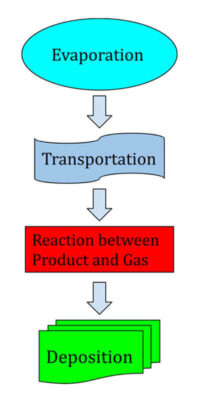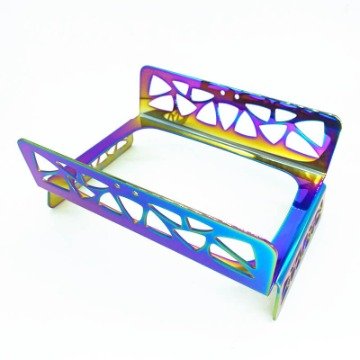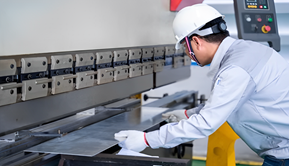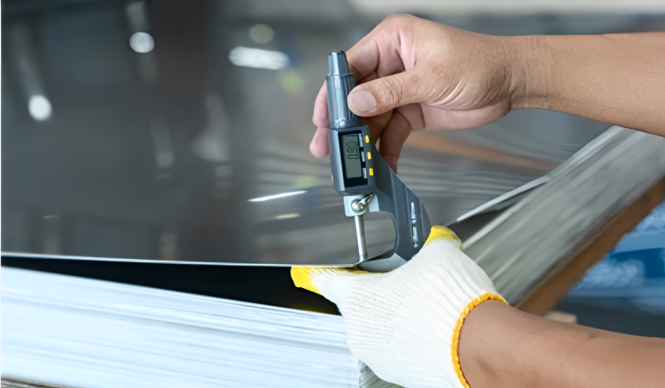PVD Coating From Concept to Application

Table of Contents
ToggleIntroduction:
Coating various materials has become a common practice on the industrial scale. This is because it is a sophisticated way of boosting the properties of different components. It is an effective method of enhancing various attributes of the materials, including their resistance capability, thermal stability, durability, aesthetic appearance, etc. During this technique, a solid material undergoes vapourization and is deposited under controlled conditions on other materials’ surfaces.
If you lack knowledge about PVD coating and want to gain more information, then stay right here. This article will discuss detailed information about PVD coating, including types, surface preparations, target materials, process, advantages, applications, limitations and other exciting details.
What is PVD Coating?
In this method, a solid material is deposited on the surface of another material after vaporizing in a vacuum environment. Consequently, the coated material offers excellent durability and corrosion resistance and delivers high performance.

It also enhances the coated material’s functional properties, improving its electrical conductivity or thermal insulation and elevating its aesthetic appearance. Due to these reasons, it is highly adopted in various industries, including aerospace, automotive, architecture, electronics, etc.
The gap, between the target material and substrate can be adjusted by shifting the shaft based on requirements.
Benefits of Electron beam PVD Coating;
- Allows for uniform coating on geometries
- Suitable for applying layers
- Environmentally friendly method
- High deposition rate
Drawbacks of Electron beam PVD Coating;
- Risk of contaminating the chamber surface
- Not always compatible with certain materials
Thermal Evaporation Deposition;
This process takes place in a vacuum chamber equipped with a heater and evaporator. The coating material is. Evaporated using a filament leading to its transformation into gas vapor.
Later, these gas vapours deposit on the surface of the substrate, forming a thin film coating.
Advantages of Thermal Evaporation Deposition:
- It is a simple technique because it requires less equipment
- Eco-friendly
- Ensure a high rate of deposition
- Cost-effective process
Disadvantages of Thermal Evaporation Deposition:
- Only suitable for materials having low melting points
- Not suitable for complex components
- Substrate requires a water-cooling system to lower the temperature
Cathodic Arc Evaporation:
The cathodic arc evaporation PVD coating method uses an electric arc to evaporate the target coating substance. As a result, the vapours produced by the evaporation start depositing on the surface of the substrate and form a thin, durable coating.
Advantages of Cathodic Arc Evaporation:
- Ensure uniform thicknesses
- Ideal for achieving hard, dense coatings
- Suitable for a wide range of materials
- Inexpensive process
Disadvantages of Cathodic Arc Evaporation:
- Macroparticle formation under certain conditions
- Require a water-cooling system for uniform coating
Pulsed Laser Deposition:
It is a highly advanced PVD coating method that uses a laser beam to coat the substrate. This method initially evaporates the coated material using high-power laser beams. After evaporation, the vapours deposit on the surface of the substrate and end up as a thin coating.
Advantages of Pulsed Laser Deposition:
- Ideal for compounds having low melting points
- All types of substances can be coated
- Ensure minimal contamination
Disadvantages of Pulsed Laser Deposition:
- High cost because of expensive equipment
- Absence of an effective commercial machine
Surface Preparation for PVD Coating:
Before PVD coating, the surface of the substrate should be treated. The reason is that improper surface preparation can lead to the poor coating of the substrate. Surface preparation for PVD coating should be done using the following steps:

Ultrasonic Cleaning:
It is the most common method for adequately cleaning the substrate to prepare its surface for PVD coating. During ultrasonic cleaning, cavitation bubbles are created using high-frequency sound waves in a cleaning solution. As cavitation bubbles are produced, they start generating waves with high pressure. In return, the generated high-pressure waves perfectly remove the debris particles present on the substrate’s surface, and the surface is cleaned thoroughly.
Rinsing:
Once the surface of the substrate is cleaned, it is rinsed thoroughly. Rinsing is done using deionized water that helps remove the cleaning solution on the surface altogether. It is crucial to rinse the substrate surface because skipping the rinsing step can badly affect the coating process. The cleaning solution may interact with the coating process, resulting in poor adhesion and irregular coating.
Drying:
Drying is the final step in the surface preparation of PVD coating. After rinsing, drying the surface of the substrate is essential for effectively removing moisture. The drying process is done using an air dryer or a drying oven, which ensures excellent adhesion and better quality surface finish of the coated parts.
Besides following the steps mentioned above, the following information must be considered to ensure an efficient PVD coating process.
- Initially, you must clean the surface of the substrate thoroughly. Clean it using a solvent-based cleaner or other appropriate cleaning solution to remove dust, contaminants or other debris particles.
- Before PVD coating, the substrate must not undergo any surface finishing treatments. This is because it can lead to poor coating and adhesion.
- Heat should not be generated excessively while surface grinding. Otherwise, it will cause the production of stress cracks on the surface of the substrate that can end up in poor adhesion.
- Burr removal is essential before proceeding to PVD coating. If you remove the burr after coating, a void will be left on the coated surface, which will affect the quality of the coating and give a poor finish.
- Before PVD coating, appropriate polishing techniques should be adopted. Polishing compounds containing silicons must be prevented as the presence of silicon can cause adhesion issues due to leaving silicon residues.
What are the common PVD coating target materials?
Target materials are the ones that are vaporized during PVD coating to create a smooth, thin layer on the surface of the substrate. A wide range of target materials are used based on specific requirements. Here are the common PVD coating target materials.

Metals:
They are commonly used as tungsten material during PVD coating. These mainly include aluminium, copper, tungsten, titanium, chromium or titan. These metals are specifically known for their exceptional thermal, electrical and mechanical properties. The type of metals used depends on the PVD coating’s required features.
Ceramics:
Ceramics are the versatile materials used for coating substrates in the PVD coating process. Some ceramics materials include zirconium dioxide, aluminium oxide, and titanium dioxide. These are used explicitly when excellent thermal stability, abrasion resistance and hardness are needed.
Dielectric Materials:
Dielectric materials such as tantalum oxide and silicon dioxide are also used as target materials in PVD coating. They are used explicitly when anti-reflective and optimal coatings are the primary requirement.
Intermetallics Materials:
Intermetallics materials are specifically adopted when there is a high demand for thermal and mechanical properties. Some frequently used intermetallic materials include nickel-titanium and titanium-aluminium-vanadium.
Alloys;
Alloys such as chromium nitride, titanium nitride and titanium aluminum are commonly utilized for creating coatings with high corrosion resistance or hardness, on surfaces.
Steps Involved in PVD Coating;

The PVD coating procedure comprises the following stages;
Thorough Cleaning;
The surface is cleaned to eliminate any debris, contaminants or impurities. This cleaning process may involve mechanical methods to ensure adhesion and a smooth flawless coating surface.
They also have a role, in altering the characteristics of the coating, which can impact its durability and other attributes.
Thermal Evaporation Deposition;
This process takes place in a vacuum chamber equipped with a heater and evaporator. The coating material is. Evaporated using a filament leading to its transformation into gas vapor.
Coating;
This stage involves applying the desired material onto the surface of the base material to create a coating. The application process is carefully controlled, considering factors like pressure and temperature. Any adjustments to these conditions can lead to changes in the properties of the surface.
Post Coating Processes;
Following the coating process various treatments are applied to ensure that it meets requirements. If it meets expectations additional treatments are carried out to enhance the bond, between the coating and substrate.
Are PVD coatings safe?
In general PVD (Physical Vapor Deposition) coatings are considered safe when applied following recommended guidelines. Here are some points to consider regarding the safety of PVD coatings;

- Biocompatibility; Many PVD coatings like titanium nitride (TiN) and titanium carbonitride (TiCN) are biocompatible and widely used in implants and devices indicating their safety for use.
- Environmental Impact; Compared to processes like electroplating that involve chemicals PVD coatings are typically eco friendly. They often utilize toxic gases during production, with minimal waste generation.
- Surface Stability; Once you apply PVD coatings they stay chemically stable and inert. This means they won’t likely react or release any substances under use conditions.
- Considerations, for Use; Although the coatings themselves are generally safe it’s important to be cautious during the application process to prevent exposure of operators and the environment to any hazards related to the PVD process (such as handling gases or disposing of by products).
- Compliance with Regulations; Manufacturers of PVD coatings should adhere to safety and regulations. Customers should also ensure that coatings used in areas (like food processing equipment or medical devices) meet industry standards.
- Choosing Materials; Some materials used in PVD coatings, such as chromium compounds may pose health risks if mishandled or improperly disposed of. However modern PVD technologies often reduce the use of materials. Incorporate them into controlled processes.
In conclusion PVD coatings are considered safe for applications when used in accordance with industry standards. It is crucial, for manufacturers and users to adhere to recommended practices to guarantee the safety and effectiveness of products coated with PVD technology.
If you have any worries regarding the safety of a PVD coating it’s advisable to seek guidance, from professionals or refer to the safety data sheets offered by the manufacturer for detailed insights.
Advantages of PVD coating:
PVD coating is considered a beneficial process across a wide range of industries due to offering several performance, energy, budget and time benefits.

- PVD coating helps improve the surface properties of the materials, including their resistance, hardness, durability, etc. Thus, it automatically improves the performance of the coated substance.
- It boosted the coated substance’s durability, consequently improving its productivity.
- The coated layer formed due to the PVS coating offers excellent wear resistance. Consequently, it reduces the chances of damage caused by wear.
- The PV-coated coating exhibits excellent lubrication, which helps reduce friction immensely and provides a smooth surface. Reduced friction not only improves the efficiency of the coated substance but also boosts its overall functioning.
- As a result of PVD coating, a smooth, protective barrier is formed on the surface of the PVD-coated parts. This barrier enhances its properties, such as hardness, resistance, etc., and prevents its surface from degrading. Hence, it increases the longevity of coated parts.
- As discussed earlier, PVD coating provides a smooth surface of coated parts. Because of increased smoothness, friction of the coated parts is also reduced during the machining operations. Thus, the need to use cutting oils along with fuels is also minimized.
- The PVD-coated substances effectively tolerate high temperatures without affecting their quality and performance. This quality helps in elevating their operating temperatures.
- The enhanced lubrication of PVD-coated parts minimizes the need for tool changes during various processes. It plays a role in reducing the cost of labour.
- PVD coating efficiently improves the tool’s life by reducing the chances of its breakage or replacement. Thus, it saves time by enhancing the manufacturing process’s speed, reducing machines’ downtime and increasing productivity.
The colors of PVD coating
The shades of PVD coatings
PVD (Physical Vapor Deposition) coatings can display a range of colors based on the materials and process conditions. Some common color options, for PVD coatings are;

- Gold; Obtained through the use of titanium nitride (TiN) or titanium carbonitride (TiCN) coatings, which’re popular for both functional purposes.
- Silver; Achieved by applying chromium nitride (CrN) or zirconium nitride (ZrN) coatings giving an contemporary look.
- Black; Produced using titanium carbonitride (TiCN) or chromium nitride (CrN) with process adjustments often chosen for an high tech aesthetic.
- Grey; Attainable with titanium aluminum nitride (TiAlN) or chromium nitride (CrN) coatings offering versatility that complements applications.
- Bronze/Copper; Formed through versions of titanium nitride (TiN) or zirconium nitride (ZrN) coatings adding warmth and elegance, to surfaces.
- Blue; Created using titanium aluminum nitride (TiAlN) coatings.
Blue coatings are quite eye catching. Serve both practical purposes.
- Rainbow/Multi color; Achieved by mixing materials and adjusting the coating conditions resulting in an appealing and vibrant surface.
The appearance and hue of a PVD coating can vary based on factors such, as the base material being coated the thickness of the coating the surface finish underneath. The specific PVD technique employed. Different manufacturers may also provide customized colors to meet needs.
Applications of PVD coating:
PVD coating offers numerous advantages because of its endless benefits. Let us discuss its typical industrial applications.

- Despite being lightweight and thin, PVD coated offers excellent corrosion and wear resistance, durability and withstand temperature changes. Thus, it is widely used in the aerospace industry to coat components, including fasteners, turbine blades, etc.
- It is a standard coating process in the automotive sector. This is because reduced friction and increased resistance to wear and corrosion are the main requirements in the automotive industry, and PVD-coated parts ensure better resistance to wear and corrosion along with reduced friction.
- PVD coating processes provide applications in the medical sector because of their high biocompatibility. Additionally, its high resistance and durability are considered perfect for coating medical instruments such as orthopaedic devices, surgical instruments, etc.
- In the tooling industry, PVD coating boosts the maintenance and cutting capability of various tools and other tooling components. It also helps in enhancing their longevity.
- PVD coating plays a crucial role in the electronic industry as it enhances the reliability and durability of electronic devices by increasing their lifespan and abrasion resistance.
Environmental Impact of PVD coating:
PVD coating is considered one of the most eco-friendly coating techniques compared to other methods. The high eco-friendliness of the PVD coating process is due to the following reasons.
- PVD coating is considered environmentally friendly because of the low usage of chemical baths or liquid solvents. The lack of chemicals dramatically reduces the chances of chemical contamination.
- It doesn’t produce any types of gasses during the coating process. Additionally, waste generation is also minimal. Waste is usually made in solid form, either recycled or reused, preventing environmental pollution.
- The target materials, substrate, and other substances used during the PVD coating process are non-toxic and harmless and provide significant environmental advantages.
- The coating formed due to the PVD coating technique doesn’t affect and reduces the recyclability of the base material. Thus, it is considered environmentally friendly.
- PVD coating is an energy-efficient process known for its low energy consumption due to advanced energy-efficient systems. Utilizing fewer energy sources provides excellent environmental benefits.
PVD Coating, versus Coating Methods
PVD (Physical Vapor Deposition);
Physical Vapor Deposition (PVD) is a coating procedure that applies films onto a surface by using methods like evaporation or sputtering. In PVD, atoms or molecules of the material are turned into vapor from a source, such as a metal target within a vacuum setting. These vaporized particles settle on the surface forming a film. PVD coatings can be metallic, ceramic or composite. Are recognized for their adhesion, durability and resistance to wear. Typical uses of PVD coatings include finishes (like gold or silver hues) wear resistant coatings (such as titanium nitride) and safeguarding against corrosion in sectors like automotive, aerospace and electronics.
CVD (Chemical Vapor Deposition);
Chemical Vapor Deposition (CVD) is a method, for applying films by causing chemical reactions of precursor gases on a surface.
In the field of CVD gases with the desired coating materials undergo reactions, near or on the substrate to create a coating layer. CVD coatings are known for their ability to be uniform, conformal and achieve film thicknesses down to the nanometer scale. This technology is commonly utilized in semiconductor production due to its control over film composition and thickness. Materials like silicon nitride, silicon carbide and diamond like carbon (DLC) are commonly used in CVD coatings for applications ranging from coatings to layers on cutting tools.
Atomic Layer Deposition (ALD);
ALD is a type of chemical vapor deposition (CVD) that allows for the deposition of thin films with precise atomic level accuracy. In ALD precursor gases are pulsed sequentially onto a surface enabling one layer at a time to react and form a solid film. The meticulous control over film thickness and composition makes ALD ideal for applications that demand uniform and conformal coatings on intricate or high aspect ratio structures. ALD finds use in microelectronics for thin film transistors energy storage devices such, as lithium ion batteries and advanced barrier coatings.
ALD is frequently used to deposit materials, like oxides, nitrides and metals serving a range of purposes, from nanotechnology to enhancing surfaces in devices.
Limitations & Challenges of PVD Coating:
Besides offering numerous benefits, the PVD coating process also has various limitations and challenges, which are as follows.
- The most notable limitation of the PVD coating technique is substrate compatibility. The substrate must be compatible with the processes required, including withstanding temperature and high vacuum conditions. The materials that meet these requirements can’t be used as substrates.
- The PVD coating process may not be suitable for components featuring complex geometries, such as parts having undercuts or other features. Coating such components can result in uneven coverage that can reduce the performance and aesthetic appearance of the coated surfaces.
- One of the limitations of the PVD coating is its high capital cost. This is because coating the components with a large surface area may cost a lot of money and prove expensive.
- PVD coating allows a very low rate of deposition during the coating process. Thus, it is unsuitable when quick deposition is a priority.
- The operating and maintenance cost of the PVD coating process is very high. Thus, it is not considered suitable for small-scale production.
Conclusion:
It is concluded that PVD coating is a remarkable, advanced coating process that exceptionally enhances the properties of coated substances. It improves the hardness, durability, corrosion, wear and abrasion resistance of the coated substances and makes them aesthetically pleasing. Improving these properties efficiently enhances the performance and longevity of the materials and makes it a prioritized coating method in worldwide industries. Additionally, it is environmentally friendly because it does not emit toxic gasses or waste. Choosing PVD coating for your substances can provide uncountable benefits and ensure longevity.

Send Your Inquiry Today


+86-18969433502
sales@sheetmetalmasion.com


